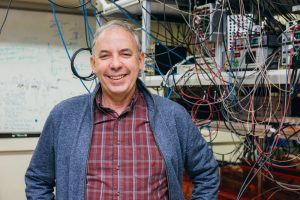Wisconsin Quantum Institute director Mark Saffman and his research group are part of a team that will attempt to make quantum computing hardware more applicable to real-world problems.
The up to $7.4 million Defense Advanced Research Projects Agency (DARPA) funding is through the ONISQ program — Optimization with Noisy Intermediate-Scale Quantum devices. ColdQuanta is the primary recipient of the funding, and Saffman’s group at the University of Wisconsin–Madison, along with a national lab and other universities, are partners.
“We’re in this era of development of quantum computing hardware that has been termed NISQ, and that’s because we don’t have error correction running on our quantum hardware,” says Saffman, who is also a UW–Madison professor of physics and chief scientist for quantum information at ColdQuanta. “The question is, can we do anything useful with this? Because the outlook for having a real error-corrected quantum computer that you could run very long calculations still seems to be a long way away, but we have these NISQ machines today, and they’re getting better all the time.”

Saffman’s lab specializes in the development of one type of quantum computer known as a neutral atom quantum computer, in which individual atoms can serve as qubits, or quantum bits. The ONISQ program is looking to apply NISQ-era hardware to complex optimization problems that would be too difficult or time-consuming for a classical computer to solve. In this case, Saffman’s group is taking on a combinatorial optimization problem, known as Max-Cut.
“Very briefly, the problem is, if I gave you a graph with a bunch of locations in the graph that are connected by lines, and I wanted to divide the graph into two sets of locations such that there’s the maximum possible number of connections between locations in one group and locations in the other group,” Saffman explains. “It sounds like a totally abstract mathematician’s problem, but it turns out there are all kinds of practical applications, including logistics deployment, self-organized pattern recognition, scheduling problems — it actually comes up in a lot of everyday things.”
The project is divided into two phases, and the team needs to reach benchmarks in phase one, set by DARPA, in order to continue into the second phase. The most important metric, Saffman says, is one that takes into account the number of qubits on the processor (N) and the number of iterations that underlie how the computed algorithm works (P), or N x P.
“We’re going to be solving this Max-Cut problem using something called QAOA, quantum approximate optimization algorithm. The QAOA involves running a sequence of quantum gates, and so the metric for DARPA for phase one is to reach N times P equals 100, and N times P equals 10,000 for phase two,” Saffman says. “No one has specifically demonstrated N times P equals 100 to my knowledge, so it is an advance, but one that is within striking distance.”
Other partners in this grant include Raytheon Technologies, Argonne National Laboratory, University of Chicago, NIST Gaithersburg, University of Colorado Boulder, University of Innsbruck, and Tufts University.